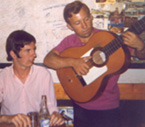Welcome to one of the most active flamenco sites on the Internet. Guests can read most posts but if you want to participate click here to register.
This site is dedicated to the memory of Paco de Lucía, Ron Mitchell, Guy Williams, Linda Elvira, Philip John Lee, Craig Eros, Ben Woods, David Serva and Tom Blackshear who went ahead of us.
We receive 12,200 visitors a month from 200 countries and 1.7 million page impressions a year. To advertise on this site please contact us.
|

|
|
What causes wolf tones?
|
You are logged in as Guest
|
|
Users viewing this topic: none
|
|
Login  | |
|

   
Ricardo
Posts: 14801
Joined: Dec. 14 2004
From: Washington DC

|
 RE: What causes wolf tones? (in reply to a_arnold) RE: What causes wolf tones? (in reply to a_arnold)
|
|
|
I think, according to Ramirez book which covers this in detail, it is a bit of a mistery what causes wolf notes. As described, I have never noticed them on ANY guitar I have ever played, but I could be playing through them unknowingly. They are weaker notes than all the rest if played with equal force. Segovia complained about them getting worse on his Hauser, and had to cut some pieces out of his repertoire because the weak note ended up being one he wanted "brought out". I have notice in live settings with microphone when some notes are weak or too strong, but that is not the same as "wolf notes" I think.
Anyway, Ramirez talks about how this is weird but common problem in old violins and cellos etc, they tried to fix by vibrating the top with metal filings on the wood. The metal fillings would gather up in areas not vibrating strong enough. So the luthier would file that spot to thin the wood. The player would play the violin and the wolf note would disappear for a while. Then unexplainably the weak note comes back, even weaker than before. Essentially, fixing the instrument made it worse, or ruined. So Ramirez did not even try that to fix the problem Segovia had. Instead he studies spherical acoustics and designed a fin of wood, with the body shape cut out smaller inside the guitar, and this supposedly fixed the problem. His designed is patented so no other maker can use it. The instrument is called "De Camara" guitar, and has been around since 1985 I think.
Like I said, I never noticed these wolf notes so hard to say if I would notice the supposed improvement this guitar has.
Ricardo
|
|
|
|
REPORT THIS POST AS INAPPROPRIATE |
Date Apr. 6 2007 16:34:39
 |
|

   
Ricardo
Posts: 14801
Joined: Dec. 14 2004
From: Washington DC

|
 RE: What causes wolf tones? (in reply to nhills) RE: What causes wolf tones? (in reply to nhills)
|
|
|
quote:
Wolf notes can also be notes that are unusually strong, rather than weak. They seem to occur when the natural resonant frequency of a top, brace, etc. coincides exactly with a note that is played.
Well, I know what you mean there, and I did not think that was what was meant in Ramirez book. But you know, I have never played a guitar that did not tap at SOME frequency. And all the frequencies are possible on the strings as overtones, so I don't see how a luthier could avoid having some stronger notes. Majority of guitars i have played, especially miked up live, you notice this vibration and the exact frequency when you stick the mic right in the sound hole and tap the board. MOST guitars have a very strong note in the bass between G and Bb in my experience. Playing those notes on the guitar you can suddenly notice one of those notes is VERY strong in at least two octaves. For live sound, once you notch that frequency out, the ENTIRE sound of the guitar gets weaker, but more clear. From there you boost the level and you are good to go.
Ricardo
|
|
|
|
REPORT THIS POST AS INAPPROPRIATE |
Date Apr. 8 2007 5:01:57
 |
|
 New Messages New Messages |
 No New Messages No New Messages |
 Hot Topic w/ New Messages Hot Topic w/ New Messages |
 Hot Topic w/o New Messages Hot Topic w/o New Messages |
 Locked w/ New Messages Locked w/ New Messages |
 Locked w/o New Messages Locked w/o New Messages |
|
 Post New Thread
Post New Thread
 Reply to Message
Reply to Message
 Post New Poll
Post New Poll
 Submit Vote
Submit Vote
 Delete My Own Post
Delete My Own Post
 Delete My Own Thread
Delete My Own Thread
 Rate Posts
Rate Posts
|
|
|
Forum Software powered by ASP Playground Advanced Edition 2.0.5
Copyright © 2000 - 2003 ASPPlayground.NET |
0.078125 secs.
|


 Printable Version
Printable Version








 New Messages
New Messages No New Messages
No New Messages Hot Topic w/ New Messages
Hot Topic w/ New Messages Hot Topic w/o New Messages
Hot Topic w/o New Messages Locked w/ New Messages
Locked w/ New Messages Locked w/o New Messages
Locked w/o New Messages Post New Thread
Post New Thread